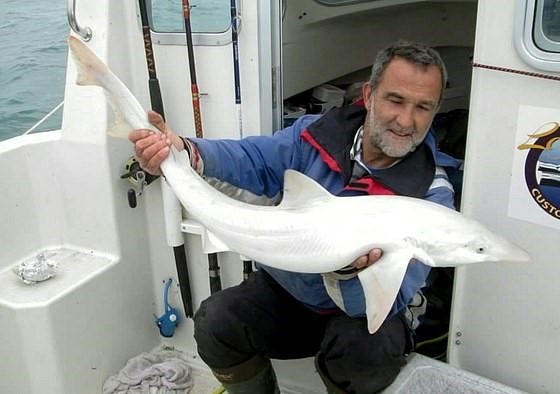The first-ever all-white shark was captured off Britain near the Isle of Wight by the 50-year-old man named Jason Gillespie while he was deep-sea fishing with some friends on Tuesday.
The albino shark measures 3 ft and entirely white, unlike any other shark ever found. It is a very rare type of shark being leucistic, which means it lost all pigment of its skin.
Gillepsie, usually released back to the sea, a tope shark get captures but reeled the albino shark first and took a few snaps of it before letting it go back to the water.
READ: Walking Sharks Are Evolved by Speciation When Extraneous Conditions Like Isolation Create Mutations
Rare Albino Shark
In an interview, Gillepsie said that he has never seen an all-white shark before for over 30 years of him fishing. The shark has the condition where the pigment dies out of the skin.

The all-white shark is similar to the albino possessing white skin and red eyes. Gillepsie recalled capturing the albino shark last Tuesday off the Isle of Wight, a once in a lifetime chance of catching a rare fish. He said there was one person who also caught an albino shark years ago but much smaller, only about 6lb.
Albino sharks struggle to survive because they do not have the same camouflage as the other sharks. Therefore they cannot hunt as effectively as them and get picked up easily by predators, says Gillepsie. He took a photo of it first before returning it to the water.
Tope sharks were first discovered in 1758, and are generally harmless to humans often found near the continental shelves, according to MarineBio.org. They can be found everywhere around the world but most commonly see in the western and eastern Atlantic, southern Baja California, and the Gulf of California.
These sharks can live for 55 years and are hunted for their meat, liver, oil, and fins. The IUCN Red List of Threatened Species has included tope sharks as one of the critically endangered species.
READ NEXT: Unbelievable! Study Reveals Actual Size of Megalodon Shark, One of the Largest Fish to Ever Exist
Albino Animals
Although rare, albino animals can be spotted everywhere. Their unique features make living in the wild difficult as they often become targets of predators.
Albinism can occur in all animals, whether they are mammals or non-mammals. But for mammals, albinism can happen when an animal inherits mutated genes from both parents that interfere with the production of melanin, the primary pigment responsible for skin color.
Meanwhile, albinism in non-mammals occurs when they produce other pigments in addition to melanin that appears entirely white. But it is important to note that not all white animals are considered albino. Some of them simply have light skin.
Albino animals in the wild face many obstacles, mainly for having eyes that put them at a disadvantage when hunting for food and avoiding their predators. Some of them also have trouble finding a mate, and their ability to camouflage makes them vulnerable to their enemies.
For instance, an albino alligator would be so easy to target, which makes it easier to get eaten before they even reach adulthood.
But sometimes there are albino animals also that succeed in the wild like the nearly one hundred population of albino squirrels in Olney, Illinois. Residents of the town feed the animals, and laws have been passed to protect them from being hit by vehicles.
READ MORE: Exceedingly Rare Ultra White Grizzly Bear Spotted!
Check out more news and information on Sharks and Albinism in Science Times.












